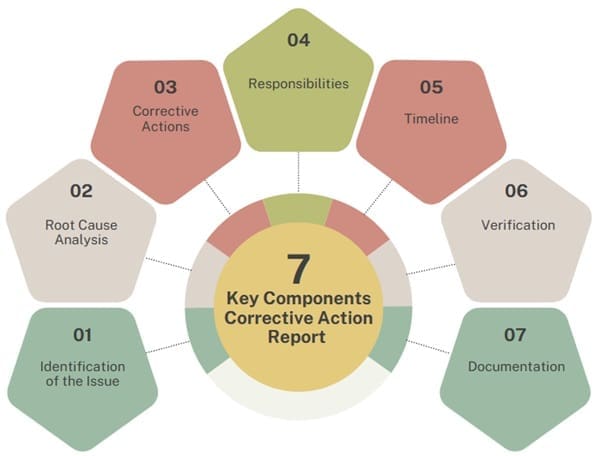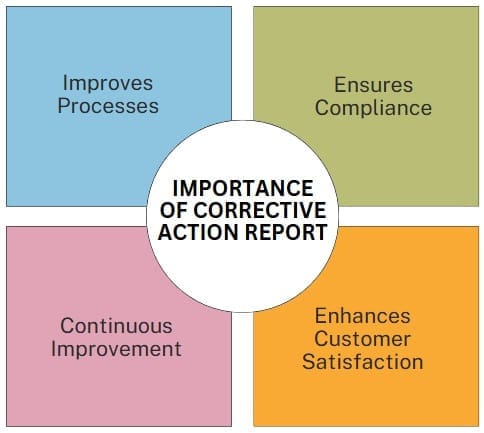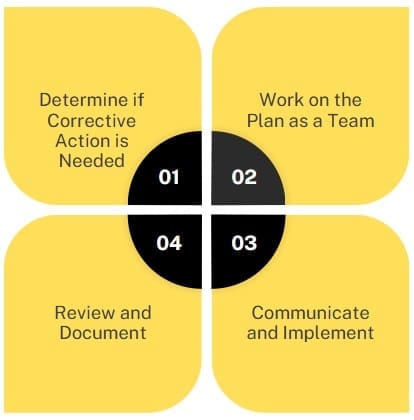Organizations use a Corrective Action Report (CAR) to address and fix issues, errors, non-conformances, or deficiencies identified in processes, products, services, or systems.
It serves as a structured framework for identifying the root cause of a problem, implementing corrective actions to resolve it, and preventing its recurrence in the future.
Table of contents
What is Corrective Action Report?
A Corrective Action Report (CAR) is a formal document organizations use to address and resolve problems or issues. It outlines the steps taken to identify the root cause of a problem, the actions needed to fix it, and the measures to prevent the issue from happening again.
The main goal of a CAR is to fully understand and correct a problem, improving processes or systems in the long term. It also helps organizations maintain quality and compliance, particularly in industries like manufacturing, healthcare, and engineering.
A CAR helps resolve problems systematically, promoting continuous improvement within an organization.
Purpose
The primary purpose of a CAR is to facilitate a thorough investigation and root cause analysis of an issue, outlining specific corrective actions to address the root cause effectively.
By doing so, organizations can mitigate the risks associated with the problem and ensure that it does not happen again, thereby enhancing the overall quality and reliability of their operations.
Key Components

A well-constructed corrective action report typically includes the following key components:
- Identification of the Issue: Clearly define the problem or non-conformance that prompted the need for corrective action.
- Root Cause Analysis: Investigate and determine the underlying cause(s) of the identified issue.
- Corrective Actions: Specify the actions to be taken to eliminate the root cause and prevent recurrence.
- Responsibilities: Assign individuals or teams responsible for implementing the corrective actions.
- Timeline: Set a timeline for the completion of each corrective action.
- Verification: Outline how the effectiveness of the corrective actions will be verified.
- Documentation: Ensure all actions and outcomes are properly documented for future reference.
Importance

- Improves Processes: By addressing the root cause, CARs improve organizational processes and reduce the chances of recurring issues. This contributes to more efficient operations and better product quality.
- Ensures Compliance: Regulated industries like healthcare, aerospace, and automotive require CARs to meet quality standards such as ISO 9001. Compliance with these standards is necessary to maintain certifications and avoid penalties.
- Enhances Customer Satisfaction: By resolving problems quickly and effectively, organizations can avoid disruptions that affect customers. A well-handled CAR can prevent delays, defects, or safety concerns, leading to improved customer trust.
- Continuous Improvement: CARs play a central role in the concept of continuous improvement. By regularly identifying and fixing issues, organizations move toward higher performance and innovation.
Creating an Effective Corrective Action Report
Creating an effective corrective action report is a systematic process that requires careful planning, analysis, and execution. Here are the key steps involved:
- Identify the Issue: Clearly define the problem or non-conformance that prompted the need for corrective action.
- Conduct Root Cause Analysis: Investigate and determine the underlying cause(s) of the identified issue.
- Define Corrective Actions: Specify the actions to eliminate the root cause and prevent recurrence by implementing corrective measures, improving processes, and monitoring for continued effectiveness.
- Assign Responsibilities: Assign individuals or teams responsible for implementing the corrective actions.
- Set a Timeline: Set a timeline for the completion of each corrective action.
- Develop an Implementation Plan: Outline how the corrective actions will be implemented.
- Monitor and Verify: Outline how the effectiveness of the corrective actions will be verified.
- Document and Communicate: Document and communicate all actions and outcomes to relevant stakeholders to ensure proper tracking and transparency.
- Follow-Up and Review: Conduct follow-up reviews to ensure the corrective actions have been effective.
- Closure: Formally close the corrective action report after completing and verifying all actions.
- Continuous Improvement: Use the findings from the corrective action report to drive continuous improvement within the organization.
Corrective Action vs. Preventive Action
While both corrective and preventive actions aim to improve processes and prevent issues, they differ in approach:
Corrective Action: Address issues that have already occurred by identifying and eliminating the root cause to prevent recurrence.
Preventive Action: Identify potential issues before they occur and implement measures to prevent them.
Certain markets and industries require Corrective and Preventive Actions (CAPA) as part of the quality management system. For example, in the medical device and pharmaceutical industries in the United States, failing to adhere to proper CAPA handling violates federal regulations on good manufacturing practices.
Implementing Corrective Actions in Compliance with ISO 9001:2015

To implement corrective actions that are compliant with ISO 9001:2015, quality managers can follow these steps:
- Determine if Corrective Action is Needed: Assess the severity of the non-conformance and decide if corrective action is necessary.
- Work on the Plan as a Team: Collaborate with the team to identify the root causes and develop appropriate corrective actions.
- Communicate and Implement: Ensure effective communication of the corrective actions and monitor their implementation.
- Review and Document: Review the effectiveness of the corrective actions and document the results for future reference.
By following these steps, organizations can effectively implement corrective actions and ensure compliance with ISO standards.
Benefits of Using Corrective Action Reports
- Transparency: The CAR ensures that all actions taken to resolve a problem are documented. This helps in tracking progress and holding responsible parties accountable.
- Quality Control: CARs improve overall quality control in an organization. By identifying and addressing recurring problems, the organization ensures consistent adherence to quality standards.
- Cost Efficiency: While implementing corrective actions may incur initial costs, they can save money in the long run by preventing costly errors, defects, or safety incidents from occurring repeatedly.
- Regulatory Compliance: Many industries, such as manufacturing and healthcare, require corrective actions to meet regulatory standards. Failing to address issues can result in fines, penalties, or loss of business.
- Data-Driven Decisions: The CAR process relies on data and evidence (such as inspection reports or failure logs) to drive decisions. This reduces guesswork and ensures more accurate problem-solving.
Challenges in Implementing Corrective Action Reports
Despite their importance, there are some common challenges when implementing CARs:
- Inaccurate Root Cause Analysis: Misidentifying the root cause prevents the corrective action from addressing the actual problem, causing the issue to recur.
- Lack of Follow-Through: Sometimes, corrective actions are proposed but not properly implemented, leaving the problem unresolved.
- Resistance to Change: Employees or teams may resist the changes suggested by the CAR, especially if they perceive the changes as disruptive or unnecessary.
- Failure to Verify Effectiveness: Even after corrective actions are implemented, failure to track and verify the results can lead to continued issues.
Final Words
Corrective Action Reports are essential tools for organizations striving to maintain and enhance the quality of their products, services, and processes. They provide a structured approach to identifying, analyzing, resolving, and preventing issues, contributing significantly to an organization’s overall success and sustainability.
By effectively implementing corrective actions, organizations can foster a culture of accountability and continuous improvement.


















